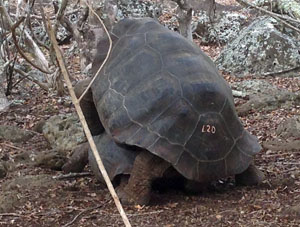ROGER'S WEB SITE | GALAPAGOS
2016
On Thursday, Nov 24th (Thanksgiving Day), we flew to
Quito to begin an 11 day excursion in Ecuador and the Galapagos
Islands, Charles Darwin's old haunt. The flights (in both
directions) were the worst part of the trip. We left home at 9:00
a.m. and flew via Houston on United, arriving in Quito at
midnight. By the time we got to our hotel it was almost 3 a.m. In
the next room, a pair of sex maniacs were enjoying themselves
loudly, clearly audible through the adjoining door. They seemed to
have an unlimited appetite for it, day and night. Thus we slept
not, missed breakfast and only managed a bus and walking tour of
old Quito in the early evening. One great surprise was that Rick,
Barb's nephew, who survived an even more arduous journey from
Vienna, was at the hotel already. We had expected to meet him in
the Galapagos. We were very pleased to see him and enjoyed a fine
meal together at Urko after the tour. Here follows many photos and
a minimum of chit-chat:
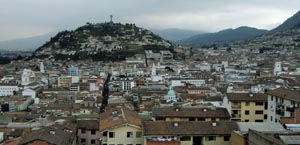
View of Quito from the Basilica (Rick)
All Photos by Roger unless noted (thus)
CLICK on any IMAGE to ENLARGE
|
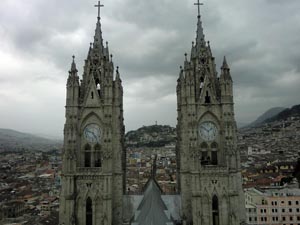
The Basilica (Rick)
|
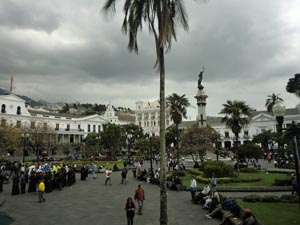
Plaza de la Independencia (Rick)
|
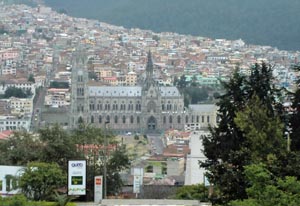
The Basilica and City (Rick)
|
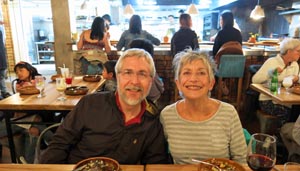
Rick and Barb in Urko
The restaurant serves small plates (see right) >
We ordered two plates each.
|
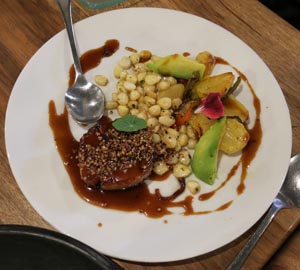
|
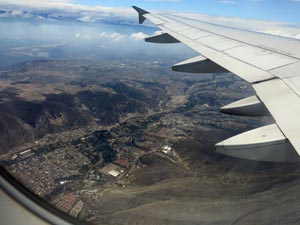
Leaving Quito
|
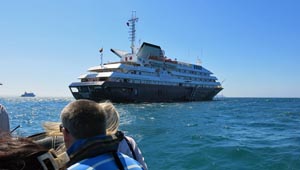
First Look at our Ship, the Silver Galapagos
(Rick)
CLICK on any IMAGE to ENLARGE
|
On Saturday, Nov 26th, we flew from Quito to Baltra,
Galapagos where our ship, Silversea Expedition's Silver
Galapagos, awaited us offshore. A small ship by cruise
standards with only 100 passengers, it is the largest ship
permitted to sail the islands. There were only about 70 on our
cruise, the week after Thanksgiving. There are two more ships this
size and many Ecuadorian boats carrying 16-30 passengers.
The islands and the surrounding ocean form a huge national park
and there are many regulations designed to protect the pristine
environment. Licensed guides accompany tourists everywhere except
in the few small towns. Our baggage was searched incoming and
outgoing to make sure we did not bring anything in or take
anything out. Any kind of discharge from the ship is prohibited.
Touching or approaching the animals is not allowed unless it
cannot be helped. The end result is a Garden of Eden where animals
thrive and are totally unafraid of humans. The cold Humboldt and
Cromwell currents surge up from the Pacific floor as they hit the
archipelago, bringing plankton, algae and other tiny life forms
that nurture the abundant food chain. At other times of the year,
the currents are dominated by warm waters from Central America
which are not so rich, so starvation and mass extinctions can
occur on the islands if the warm currents predominate too long.
The Galapagos straddle the equator. We crossed it at least twice
on our week's cruise. The climate is mild, though, cooled by the
ocean waters. Temperatures were in the 70's (20's C) while we were
there. However, the sun beats down vertically and heavy-duty sun
protection is a must.
Overnight, we moved on to Punta Vicente Roca, Isabela
where we explored the coastline of Ecuador volcano while Rick
went snorkeling in deep water. The ship's photographer Jorge
took wondrous underwater photos here and elsewhere but I am not
allowed to publish them here. I can use them in the upcoming
video of the trip, however. In the afternoon, we moved on to
Punta Espinoza, Fernandina, where we hiked over newly minted
black lava and sand at the foot of a volcano for 2 1/2 hours and
saw hundreds of iguanas, crabs and sea lions.
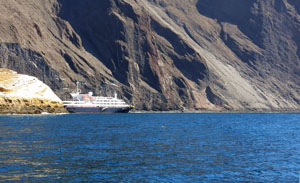
Anchored at Punta Vicente Roca
|
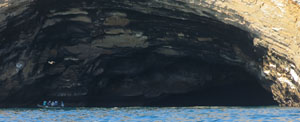
Sea Cave, Ecuador Volcano
CLICK on any IMAGE to ENLARGE
|
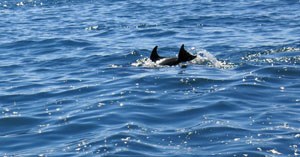
Rare Sighting of a Mola Mola (Ocean Sunfish)
Largest vertebrate
fish in the world
|
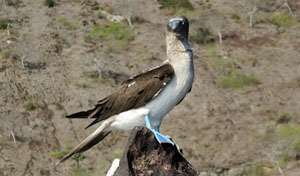
The Iconic Blue-Footed Booby (Rowan)
|
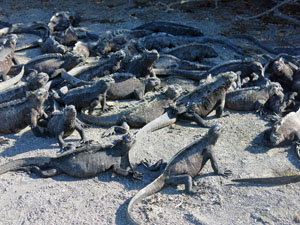
Marine Iguana Clan
|
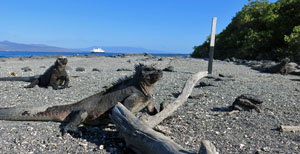
Marine Iguanas. Silver Galapagos Beyond
|
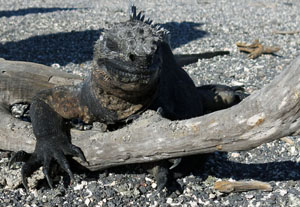
A Face Only a Mother Could Love
|
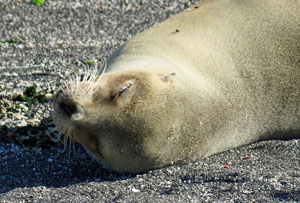
A Face Anyone Could Love
|
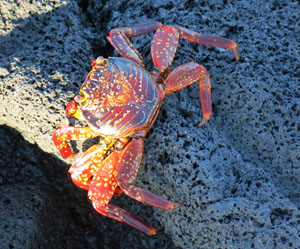
Sally Lightfoot Crab
|
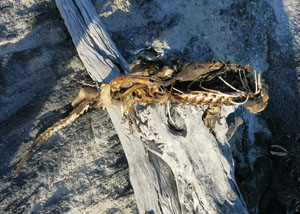
Iguana Corpse
|
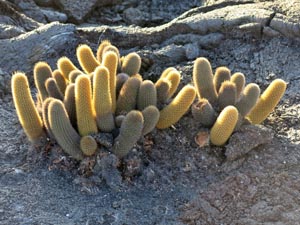
Lava Cactus
The first plant to grow on a new island
|
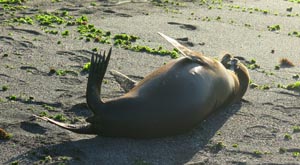
Sunbathing on the Beach
CLICK on any IMAGE to ENLARGE
|
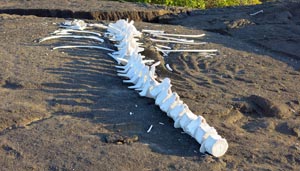
Right Whale Skeleton
|
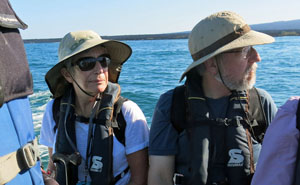
Barb and Rick Aboard a Zodiac
|
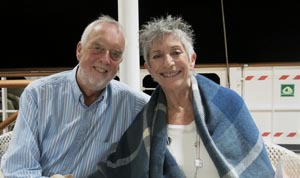
Evening at The Grill
|
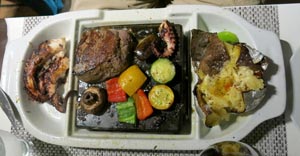
Steak and Lobster in The Grill
|
Today was the first time we were really
able to see the staggering variety and abundance of life on
the islands. Even on the young island of Fernandina, where
plants have yet to take hold, the land, sea and air are
teeming with animals.
The Galapagos Islands are formed one at a
time by the welling up of molten lava from a 'hot spot'
(weakness) in the Earth's crust. Shield volcanoes push up
thousands of feet from the ocean floor until they emerge above
the water as islands. At the same time, the tectonic plate
below is gradually moving towards the south-east.
Consequentially, the newer islands are in the west and north
and still have active volcanoes over the hot spot. They are
places of black lava and dust, populated by very few plants
such as the lava cactus (see above). As the new island moves
south-east off the hot spot, the volcanoes die and the land
becomes lush with vegetation. The higher the land, the more
rainfall it generates and the lusher it becomes. At the same
time the tectonic plate is also sinking to the east as it
slips under the South American plate. So the older islands
gradually sink once more below the sea in an inexorable
conveyor belt of life and death.
Next day, Nov 29th, we
returned to Isabela at Caleta Targus. After a 'dry' landing (no
wet feet!) by Zodiac, we hiked up 330 feet in 1 mile to a point
above Darwin Lake. This lake is way above sea level but is filled
with salt water, much to the chagrin of early seafarers who looked
here in vain for a source of fresh water. How did this happen?
There are two main theories. One is that the lake used to be at
sea level, but the whole island was uplifted taking the lake with
it. The other is that a tsunami filled the lake. Although it sits
in an area of low rainfall and so should be dry, the water is
extremely saline and resists evaporation.
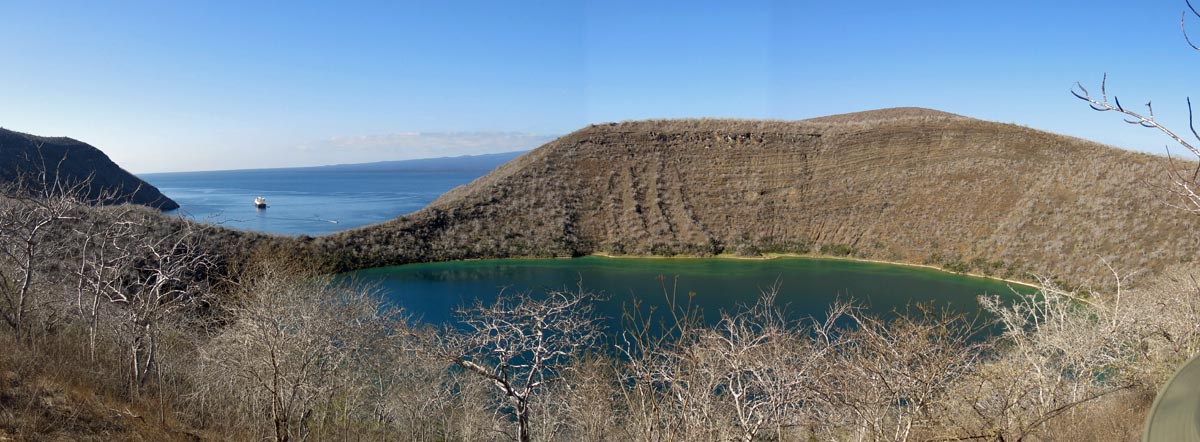
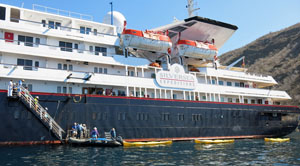
Boarding a Zodiac for the Trip Ashore
|
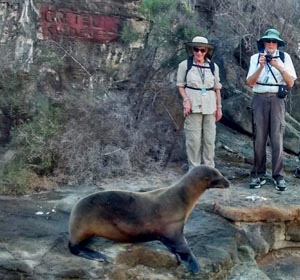
We Waited as a Sea Lion Slid Past (Carmen)
|
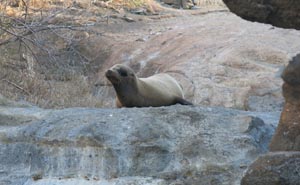
Still About 20 ft to Slide Down to the Sea
|
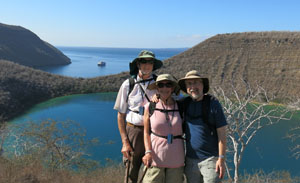
Hikers at Darwin Lake (Anon)
|
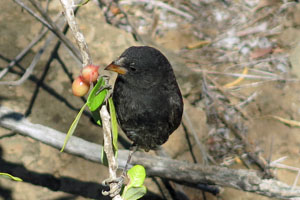
Darwin's Finch, as in "The Origin of Species"
CLICK on any IMAGE to ENLARGE
(except Lake Panorama, top, and Badge, right) |
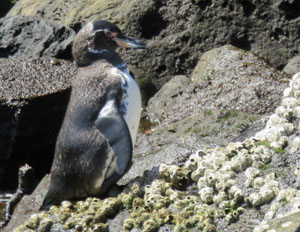
Galapagos Penguin (Rowan)
Endemic to the Galapagos, it is the only
penguin living north of the equator.
|
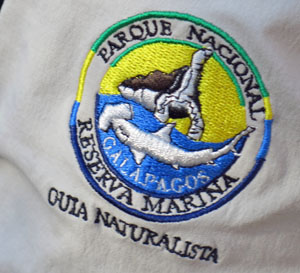
|
Our guides all proudly wore the official
badge
(left) of the Park Service. They are a fine
bunch of young Galapagos enthusiasts and all
are women (except one). All are experts and
are greatly responsible for the preservation
of this amazing natural reserve.
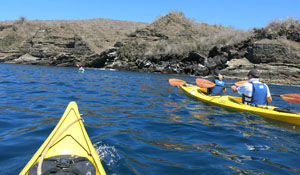
Late Morning Peaceful Paddle
|
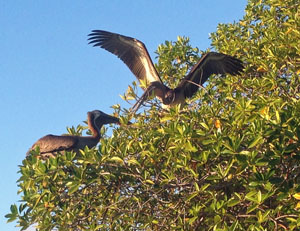
Pelicans in the Mangroves (Rick)
|
In the afternoon we sailed to
Bahia Elisabeth, still on Isabela. As we cruised, we were
treated to a lecture on "Darwin in the Galapagos" by our
naturalist, Gilda Gonzalez. I had read The Voyage of
the Beagle in preparation for this trip and had
become fascinated by the travels of the young 26 year-old
Darwin. I gleaned from his book that he was a very likable
fellow - friendly, outgoing, inquisitive and adventurous.
I could imagine myself chatting with Charlie over a beer
and a meal of giant tortoise and thoroughly enjoying the
encounter, if not the tortoise. What does not come across
in the book is that he was horribly seasick most of the
time. Gilda filled in that snippet, and many other
insights. Had he not been so sick he would not have
pleaded to go ashore so much. He covered most of South
America on foot or on horseback, collecting specimens as
he traveled. Never has a case of seasickness had such an
effect on the course of history. Incidentally, Barb
suffers from motion sickness but this time she wore a
'acupressure wrist band' and had no problem at all.
In the late afternoon we embarked on a fascinating Zodiac
tour of the mangroves on Bahia Elizabeth. These
salt-resistant trees grow up to 70ft high in the shallow
brackish inlets of the island. We cruised around, silently
at times, and saw numerous Pacific Green Sea Turtles just
below the surface, a Galapagos Hawk, Brown Noddy Terns,
and many pelicans.
|
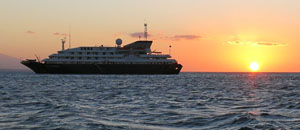
Sunset at Bahia Elisabeth
|
We sailed overnight to Post Office Bay, Floreana. Here is
the old post box in a barrel where sailors used to mail letters
home. They were sometimes years away from home with no contact
with their families or loved ones. (The voyage of the Beagle
took over 5 years). Sailors on the return route home would pick up
letters from the barrel and deliver them when they got home. The
tradition continues today but with postcards. No stamp required!
We sent one card and picked up two to deliver in Flagstaff and
Nottingham.
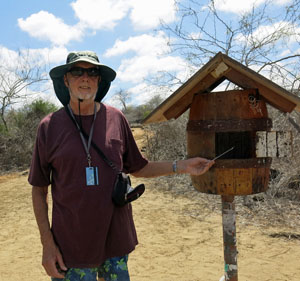
The Old Post Office Barrel
|
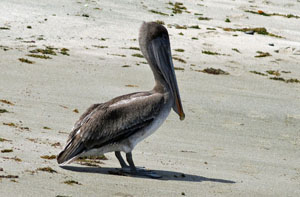
Pelican on the Beach at Post Office Bay
In the afternoon we moved on to Punta
Cormorant, Floreana and went for a Nature
Walk.
|
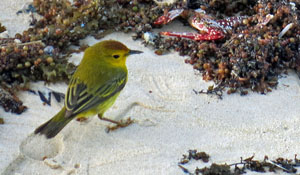
Yellow Warbler at Punta Cormorant
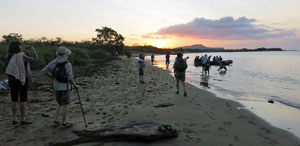
Leaving Punta Cormorant
|
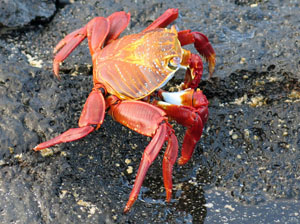
Sally Lightfoot Crab
CLICK on any IMAGE to ENLARGE
|
Next day, Dec 1st, we were anchored
off Galapaguera Cerro Colorado, San Cristobel where we rode
ashore to visit a giant tortoise breeding center and refuge.
Giant tortoises are endemic to San Cristobel. They were almost
wiped out in the 19th Century as they were a prized source of
food for sailors starved of meat. Giant tortoises can live for
months without water so they would be stacked alive in the
holds of ships until they were killed and eaten. The breeding
center incubates the eggs and nurtures the baby tortoises in
safety until they are about 5-10 years old and big enough to
survive in the wild. When fully grown they have no natural
predators, though young tortoises can be taken by hawks and
snakes.
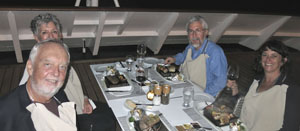 In the evening we had a last
dinner at The Grill (left), an open-air restaurant on the back
of the ship. Meat and fish is served partly cooked on hot lava
rock slabs and finished by the diner to their liking. On
the right is Rowan, an Australian lady we befriended aboard. I
will be forever in her debt (see photography footnote). There
is another larger restaurant below decks also.
In the evening we had a last
dinner at The Grill (left), an open-air restaurant on the back
of the ship. Meat and fish is served partly cooked on hot lava
rock slabs and finished by the diner to their liking. On
the right is Rowan, an Australian lady we befriended aboard. I
will be forever in her debt (see photography footnote). There
is another larger restaurant below decks also.
Silver Galapagos is one of three Silversea
Expedition ships which are smaller than the regular Silversea
Cruise Line ships. She was built in 1990 as the Galapagos
Explorer II and bought, renamed and refurbished by
Silversea in 2013. The cabins (which they call 'suites') are
larger than most and have a convertible couch in addition to a
full size double bed and a separate bathroom. Most rooms have
verandas. In spite of the refit, the cabin design is very
dated with no underbed storage for cases and poorly designed
storage elsewhere. The water pressure failed on two occasions
and the air conditioning had a mind of its own. The Ecuadorian
staff are friendly and competent and the food was mostly
excellent, if sometimes served lukewarm. All shore excursions,
food, drinks and activities are included in the cost.
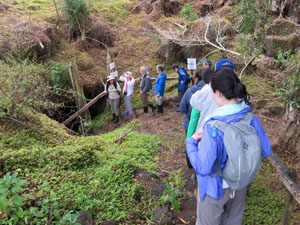 On
our last full day aboard, Dec 2nd, Barb, Rowan and Rick visited
the Los Gemelos Ecological Reserve in the muddy highlands of Santa
Cruz (Right, photo by Rowan). I flunked out because of a bad knee
and stayed on the ship. Rick's camera had died after day 2, so I
have no other photos of this 4 hour bus ride and hike.
On
our last full day aboard, Dec 2nd, Barb, Rowan and Rick visited
the Los Gemelos Ecological Reserve in the muddy highlands of Santa
Cruz (Right, photo by Rowan). I flunked out because of a bad knee
and stayed on the ship. Rick's camera had died after day 2, so I
have no other photos of this 4 hour bus ride and hike.
We had a last lunch in The Grill (below) while the ship sailed to
Puerto Ayora, Santa Cruz. We disembarked to visit the Fausto
Llarena Breeding Center which is jointly run by the Charles Darwin
Research Foundation and the Galapagos Conservancy. The highlights
here are the Giant Saddleback tortoises and land Iguanas. It is
also the last resting place of Lonesome
George, who died here in 2012 aged about 100, the last of
his subspecies of Giant Tortoise. After that we had free time in
Puerto Ayora before boarding the ship for the last time.
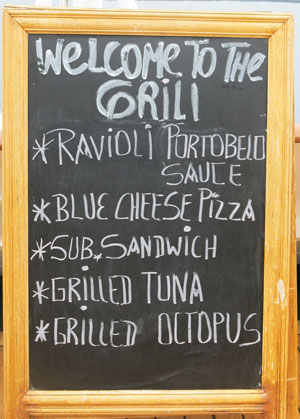
The Grill Lunch Menu (does not enlarge)
|
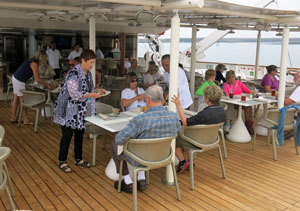
The Grill at Lunch, Dec 2nd
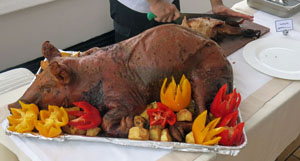
Roast Suckling Pig Special
|
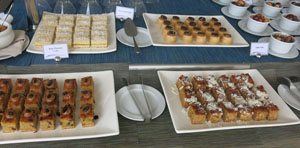
Desserts
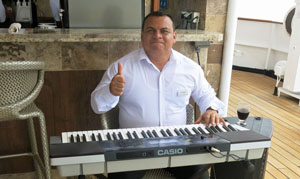
Alfredo, Silver Galapagos' Sole Entertainer
CLICK on any IMAGE to ENLARGE
|
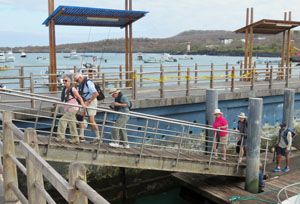
Barb Leads the Way at Puerto Ayora (Rowan)
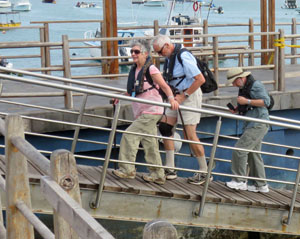
|
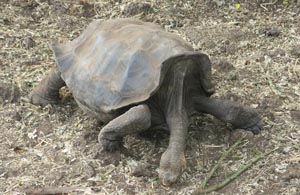
Giant Saddleback Tortoise
|
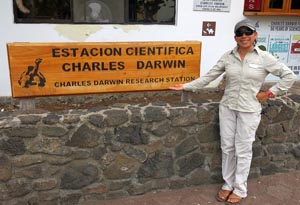
Angelica, One of Our Guides
|
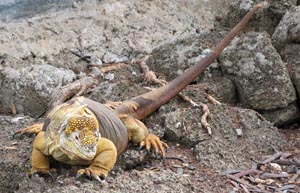
Land Iguana
|
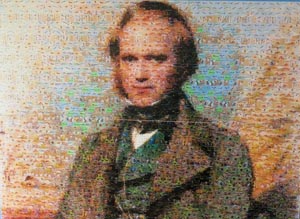
Charles Darwin Mosaic
(Made of tiny photos of Galapagos wildlife)
|
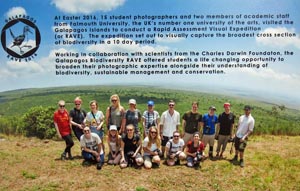
Plaque Commemorating a Falmouth
University Visit to the Darwin Center
|
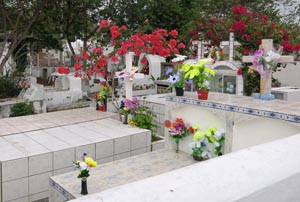
Puerto Ayora Cemetary
|
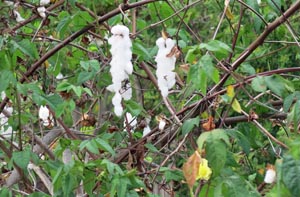
Cotton Tree in the Cemetary
|
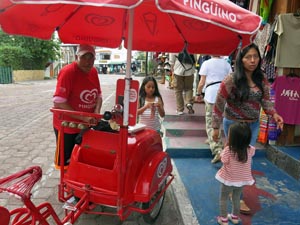
Ice Cream Vendor, Puerto Ayora
|
And so our Galapagos Gallop was over. As
you know, I am not subject to irrational exuberance, or any
kind of exuberance actually, but this was truly a Trip of a
Lifetime. It was action packed and we were tired a lot of the
time, but it was well worth it.
Photography notes: Thanks to Rowan for the shots of the
Blue-Footed Booby and the Galapagos Penguin. She also
saved my bacon when I failed to operate my video camera
properly while shooting an unusual tortoise mating scene
(right), which was followed by an attack by a second male
on the mating male. This unprecedented scene was filmed by
Rowan who kindly gave me the video for my upcoming DVD.
Rick and Rowan also contributed more photos and notes
after the first draft of this journal, for which I am very
grateful.
|
Tortoises Mating (Rick)
|
On Dec 3rd, we departed the ship at 9:30 a.m. for the 24 hour
series of flights back from Baltra via Guayaquil and Miami to
Phoenix. The less said about that the better.

HOME








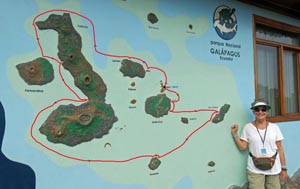
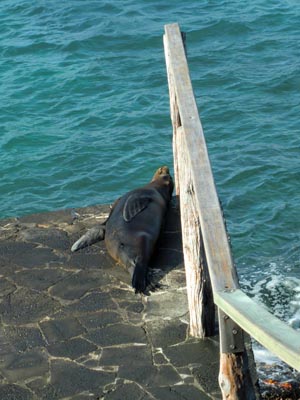
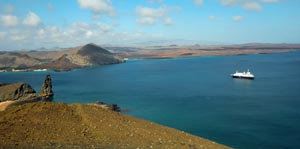
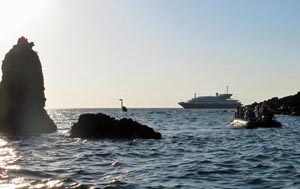
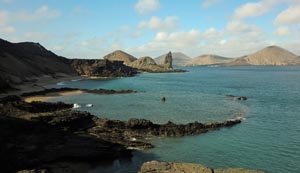
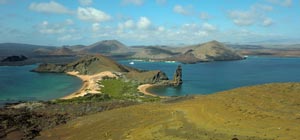
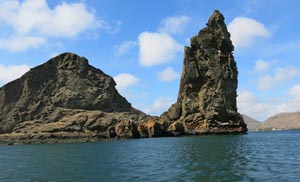
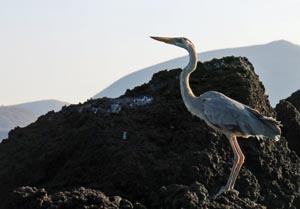
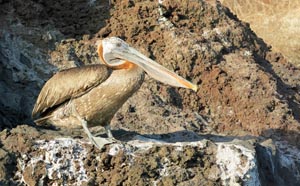
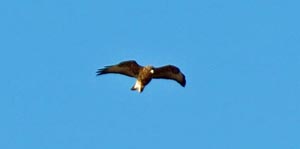
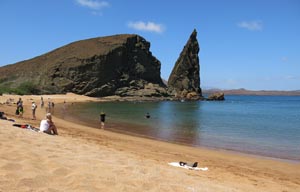
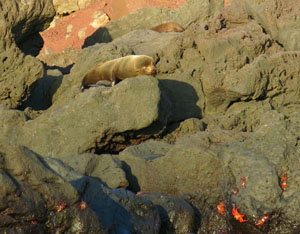
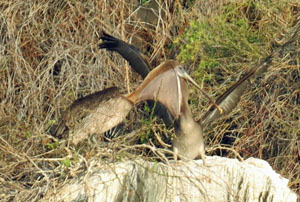
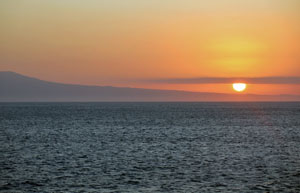































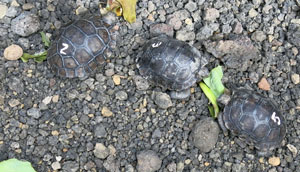
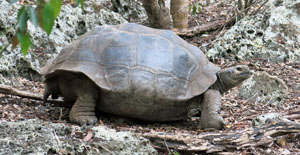
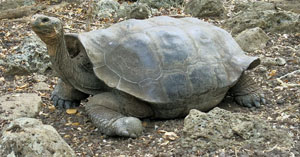
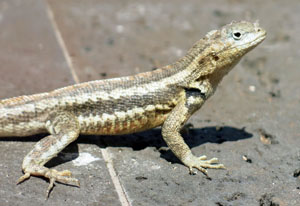
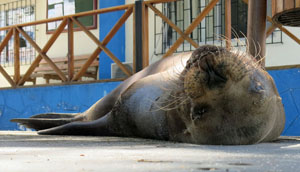
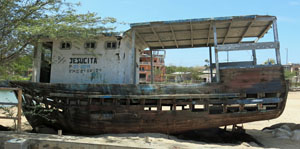
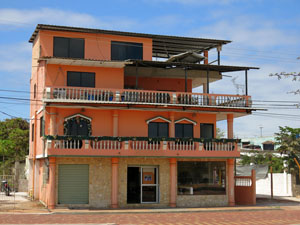
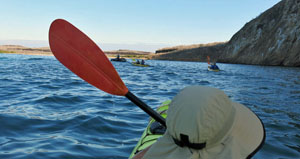

 On
our last full day aboard, Dec 2nd, Barb, Rowan and Rick visited
the Los Gemelos Ecological Reserve in the muddy highlands of Santa
Cruz (Right, photo by Rowan). I flunked out because of a bad knee
and stayed on the ship. Rick's camera had died after day 2, so I
have no other photos of this 4 hour bus ride and hike.
On
our last full day aboard, Dec 2nd, Barb, Rowan and Rick visited
the Los Gemelos Ecological Reserve in the muddy highlands of Santa
Cruz (Right, photo by Rowan). I flunked out because of a bad knee
and stayed on the ship. Rick's camera had died after day 2, so I
have no other photos of this 4 hour bus ride and hike.














